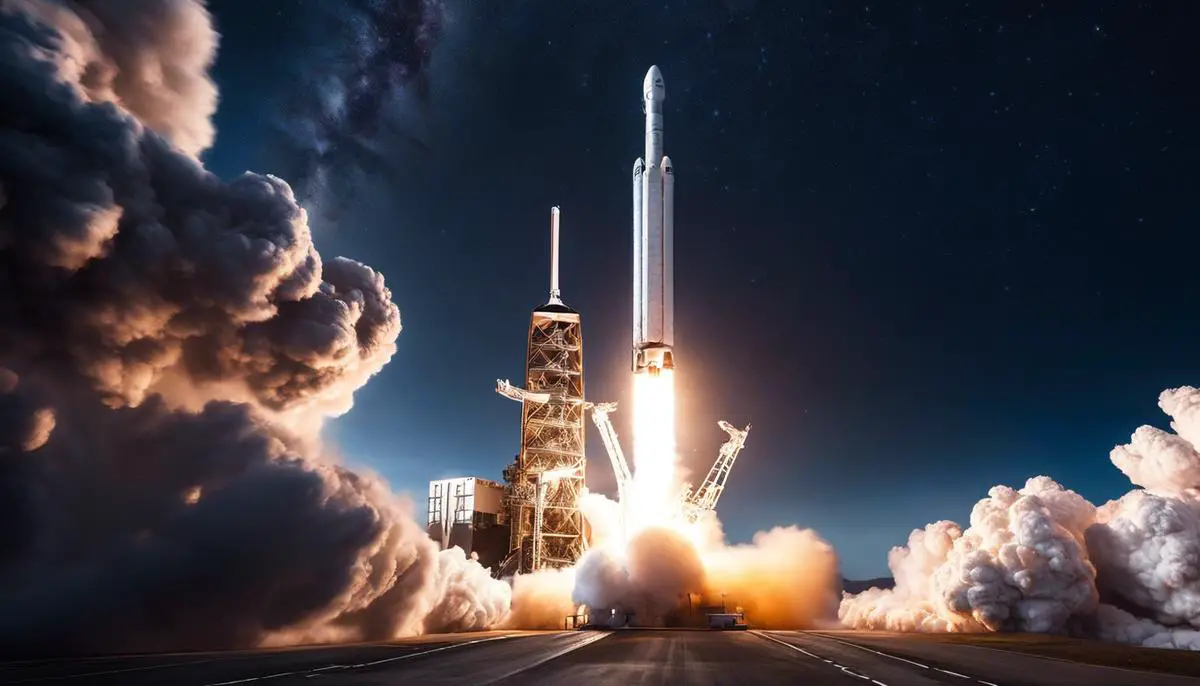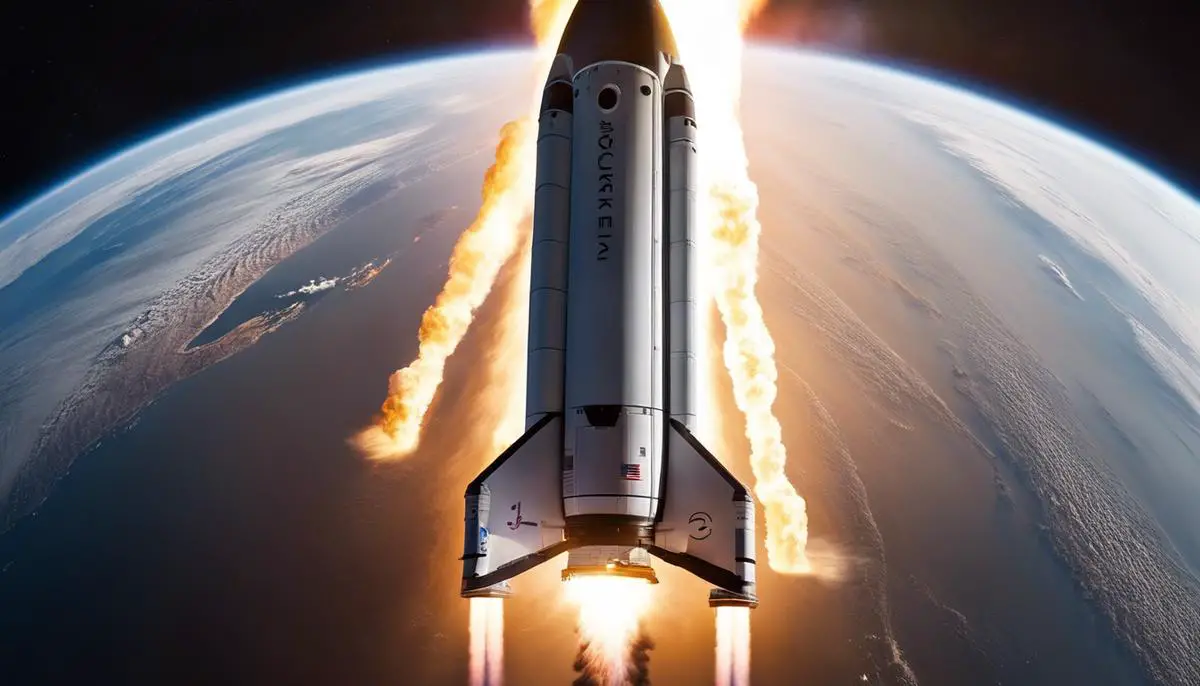At the forefront of privatizing space exploration, SpaceX, under the diligent leadership of Elon Musk, has paved the way to realize aspiring cosmic dreams. The company’s 2023 vision comes to light in the context of an intricate blend of business acumen, effective resource management, constant innovation, strategic partnerships, and an assured approach to risk management. This intricate convergence of tactics underscores Elon Musk’s unique business philosophy, which propagates SpaceX’s extraordinary evolutionary timeline and fascinating intrigue into the future. Through a critical evaluation of these factors, we gain an extensive understanding of Musk’s strategies paving SpaceX’s sustainable success for 2023 and beyond.
Musk’s Business Philosophy
As one delves into the astonishing trajectory of SpaceX, it becomes evident that much of the company’s groundbreaking success can be ascribed to an equally remarkable business philosophy. This philosophy, undone by convention and fueled by innovation, has its roots embedded in the audacious mind of its charismatic founder – Elon Musk.
Unique Business Philosophy
Musk has consistently demonstrated a unique business approach, keenly focused on innovation, sustainability, and affordability. He perceives space exploration not as a governmental privilege but as a universal endeavor, one that invites dynamic collaboration between the public and private sectors. He defies traditional industry thinking by welcoming competition, viewing it as a catalyst for rapid advancement. Moreover, within SpaceX, Musk promotes a flat organizational structure that emphasizes communication, encouraging employees at all levels to share their ideas, criticisms, and observations.
Innovation and Persistence
The lynchpin of SpaceX’s paradigm-shifting dynamism lies in its ceaseless commitment to innovation and persistence. Musk’s ambitious dream of colonizing Mars and his mission to make human life interplanetary reveal a fearlessness, bold enough to set high-risk targets. SpaceX’s concept of reusable rockets was initially met with skepticism. Despite several failures, the company persisted, and in pioneering a game-changing innovation, drastically reduced the costs associated with space travel.
Cutting Costs – Key to Success
Musk’s overarching strategy to make space accessible and affordable lies at the heart of SpaceX’s operational modus operandi. In stark contrast to how governments traditionally approach space exploration, Musk insists on studying every cost parameter with a discerning eye. SpaceX’s advancements in manufacturing rocket parts in-house, especially the cutting-edge Raptor engines, demonstrate this cost-efficiency principle in practice. It negates the reliance on external suppliers and empowers SpaceX with the capability to control costs better, enabling broader access to space exploration.
Private-Public Partnership Model
Gibing the notion of competition, Musk calls for greater synergy between different players in the space industry. His philosophy advocates for a private-public partnership model that actively garners government support and encourages competitive engagement with other private space firms. This collaborative approach has reaped dividends for SpaceX, as demonstrated by its fruitful association with NASA.
Risk Taking – A Crucial Component
A decisive influencing factor underscoring the success story of SpaceX has been Musk’s irrepressible appetite for risk. The firm’s progression from its near bankruptcy in 2008 to launching astronauts to the International Space Station in 2020 symbolizes Musk’s audacious endeavor. He had famously stated that SpaceX might fail but they’d go down fighting.
In conclusion, Elon Musk’s business approach, with its exceptional blend of innovation, cost-efficiency, collaboration, and risk acceptance, has substantially shaped SpaceX’s success story. Such ingenuity has enabled SpaceX not just to carve a niche but to redefine the norms in the space industry.

Resource Management
As we delve deeper into the resource management strategies deployed by SpaceX under the helm of Elon Musk, a term that resonates well with their approach is “vertical integration.” The term denotes the practice of controlling all stages of the production process — from manufacturing to distribution. This ethos is encapsulated within SpaceX’s operations. Such an approach cuts out middlemen — a saving that companies like SpaceX can pass onto consumers and use for further innovation and scale.
In an industry traditionally reserved for government enterprises and a select group of conglomerates, SpaceX has continuously disrupted the status quo. A significant component of SpaceX’s disruptive approach is its strategic investment in research and development (R&D). Instead of banking high profits or outsourcing the technological innovations, SpaceX spends heavily on its R&D. This strategic choice has yielded a high return on investment, with advanced spacecraft such as the Dragon and Falcon Heavy as sterling testaments of this investment.
Moreover, strategic skills development within SpaceX’s workforce plays a crucial role in resource management. The organization’s emphasis on continued learning and professional development has resulted in a competent, versatile team able to address the complex challenges that come with space exploration. Through fostering a company culture that values ingenuity and grit, SpaceX encourages its employees to take on new competencies, thereby creating a workforce that is resourceful and resilient.
Resource allocation is another pivotal strategy that SpaceX pioneers in its industry. By consciously choosing projects and missions that align with its long-term objectives — commercializing space travel, colonizing Mars, and creating an interplanetary transport system, to name a few — SpaceX ensures that every bit of resource it possesses is used to further its grand vision.
The concept of open innovation also underpins SpaceX’s strategies. Elon Musk’s 2014 announcement in which he made SpaceX’s patents available to anyone illustrates this method. His argument follows that open-source innovation can spur on industry-wide progression, ending the stifling dominance of exclusive corporations while fostering a collaborative and competitive market atmosphere.
In retrospect, tracing the distinctive resource management strategies implemented by SpaceX under Elon Musk’s leadership is much like navigating the cosmos — there are numerous lessons and insights to glean. From vertical integration to strategic investments in research and development, encouraging skills development, astute resource allocation, to embracing open innovation, these are pivotal components to SpaceX’s impressive trajectory. But just like space itself, one gets the sense that there are even more out there, waiting to be uncovered and explored. From this plethora of strategies, one message rings clear – pioneering a new frontier requires not just powerful spacecraft but also ingenious resource management strategies. We wait with bated breath to see what ‘Muskian’ strategies emerge next.

Innovation and Technology
Further to SpaceX’s notable success, worth examining is the company’s adroit customization of technology and leveraging of innovation which played a significant part in propelling their 2023 triumph. Anchored firmly to a meticulously crafted strategy that transcends sectors, SpaceX’s uptake of the latest advancements in tech manifested not as a mere fluke of luck, but resulted from purposeful industry foresight. Their strategic advantage stands testimony to the enterprising spirit that is woven into the core of the company – that has led them on their journey from nascent start-up to major space industry disruptors.
SpaceX’s technological prowess was reinforced with their groundbreaking Falcon Heavy and Starship vehicles. Both, with the capacity for impressive payload and lower expendable launching costs, have enabled SpaceX to secure a market dominance. Falcon Heavy, with the capability to lift into orbit nearly 64 metric tons, speaks volumes about SpaceX’s successful application of advanced technology, whilst offering substantial savings for their customers.
Starship, the reusable transportation system, remarkably illustrates how SpaceX has turned the science fiction of space travel into a tangible reality. This venture underlines the absolute emphasis on their long-term strategy, namely, to make life multiplanetary and pave the way for accessible space travel. The utilization of methane and liquid oxygen as rocket fuel catapults these lofty ambitions into the realm of possibility. Both these fuels are advantageous, not only for their potential presence on Mars but also due to the eventual refuels on the Martian surface.
Similarly, SpaceX’s use of Artificial Intelligence (AI) penetrates a host of its operations and is core to its strategic objectives. With AI, SpaceX has imbued operations with exceptional efficiency and precision, whilst substantially diminishing the need for human intervention. For instance, their Dragon spacecraft’s automated docking with the International Space Station, or their cutting-edge sub-system Starlink, that aims to provide satellite internet connectivity to the underserviced parts, is a testament to their company-wide adoption of AI.
SpaceX’s TechOps is another critical aspect of their power-filled arsenal. TechOps teams initiating and overseeing unique approaches to troubleshooting, has fostered a healthy culture of problem-solving, highlighting the embracement of complex and evolving tech challenges, most organisations wouldn’t dare to tackle.
In essence, SpaceX’s firm adherence to and critical dissection of the latest tech advancements not just exemplifies their forward-thinking business acumen, but has satiated their thirst for consistently pushing the boundaries of what is possible. It bodes well to remember that this success isn’t accidental; it’s the fruit of meticulous planning, an unflinching can-do attitude, and the strategic and judicious utilization of technology and innovation. With steadfast determination, SpaceX continues to chart new territory and revolutions in the space, leaving an indelible mark on mankind’s quest into the final frontier.

Photo by lanirudhreddy on Unsplash
Partnerships and Collaboration
Expanding on the multifaceted aspirations and strategies of SpaceX, it is crucial to delve deeper into the crucial role that strategic partnerships and collaborations have played in the visionary blueprint of this aerospace company’s future success. Engaging in strategic partnerships and sound collaborations quite intelligently has enabled SpaceX to stretch beyond the norms, accelerate progress, and achieve an unparalleled market reach.
A strategic partnership can underpin a company’s overall strategy, and in SpaceX’s case, this dynamic business approach has held true. SpaceX’s partnership with NASA is a resounding exemplar. The synergistic relationship between the two entities has been a game-changer, advancing the mainstays of space travel and exploration. By capitalizing on NASA’s experience, infrastructure, and funding, SpaceX leaps forward in making space travel more accessible and affordable, thereby revolutionizing the aerospace sector.
Partnerships also extend to inspiring and engaging the wider public in space exploration. Collaborating with organizations like the space education non-profit, Space Center Houston, SpaceX inspires a new generation of scientists and engineers, fostering a culture of innovation. This nurturing of collective inspiration further drives the public interest in space exploration and cements SpaceX’s positioning within the wider societal narrative.
It is also paramount to mention SpaceX’s collaborations with international space agencies. Cooperation with the likes of the European Space Agency and the Japanese Aerospace Exploration Agency are foundational in advancing SpaceX’s international relationships. Such geographically diverse partnerships not only strengthen SpaceX’s global footprint but also facilitate international scientific knowledge exchange, advancing humanity’s understanding of the universe.
The role of strategic collaborations is not limited to organizations and agencies, extending to corporations as well. For instance, partnerships with telecom giants for the Starlink project demonstrate yet another way in which SpaceX is leveraging collaborations to expand market reach and ensure its continued prominence in the satellite broadband industry.
To conclude, strategic partnerships and collaborations have wittingly served as a cornerstone of SpaceX’s future success blueprint. By engaging in such a strategic business model, SpaceX not only inspires and embraces technological advancements but also sets the stage for breakthroughs that will echo in the annals of space exploration. This insightful and pioneering approach has further built a powerhouse that stands robustly prepared to meet the challenges and opportunities of an exciting new era in space. Such a perspective delineates the long-sighted vision, strategical partnerships and collaborations have played in shaping SpaceX into an aerospace industry titan.

Risk Management

As SpaceX continues its ambitious journey towards a future of space colonization and interplanetary travel, the implementation of resourceful measures, novel technological advancements, strategic alliances, and vigilant risk management methods under Elon Musk’s visionaries leadership become essential. These multifaceted strategies, anchored on Musk’s resilient business philosophy, shape the backbone of SpaceX’s roadmap to 2023, illuminating a potent example of effectively maneuvering a company in an industry that is literally and metaphorically as vast as space itself. The ethos of SpaceX’s impending success in 2023 resides in this harmony of distinct yet converging strategies, guiding the way to a future where the exploration and colonization of outer space are realties within our grasps.
![]()
